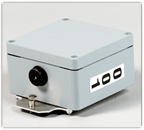Johns Hopkins integrates gunshot detection with video surveillance
By Andy Williams, Associate Editor
 Television shows like HBO’s The Wire and Homicide: Life on the Street depict Baltimore as a gritty city. While the shows are fiction, crime is a real concern and Johns Hopkins University is testing a system that detects gunshots in an effort to help keep the campus safe.
Television shows like HBO’s The Wire and Homicide: Life on the Street depict Baltimore as a gritty city. While the shows are fiction, crime is a real concern and Johns Hopkins University is testing a system that detects gunshots in an effort to help keep the campus safe.
The gunshot detection system was installed last year at Johns Hopkins University in downtown Baltimore. It hasn’t led to any arrests or even detected gunfire yet. But it has detected two car backfires. At least one university official says the system has promise.
That’s one of the reasons Johns Hopkins allowed the system, donated by its developer, Planning Systems Inc. (PSI), Reston, Va., to be installed. PSI is a technology firm that specializes in threat detection devices and whose parent company, QinetiQ North America Technology Solutions, rolled out its suicide bomb detection system last year.
Called the SECURES Gunshot Detection System, the Johns Hopkins installation relies on 93 small, almost undetectable sensors installed on city-owned streetlights and Johns Hopkins off-campus buildings surrounding the 140-acre campus.
Why Johns Hopkins? The university hadn’t asked for such a system, says Johns Hopkins spokesperson Tracey Reeves. “They (PSI) came to us. We thought of it as an added level of security for our students.” The university’s main campus, known as Homewood, has about 6,400 students.
What made Johns Hopkins desirable for PSI is that it has an extensive video surveillance system which can be integrated with SECURES, says George Orrison, PSI’s director of marketing, security technology. “Johns Hopkins is relatively close and we also had a willing partner (iXP) as a video integrator that has done work with Johns Hopkins,” he says. iXP designs and implements public safety and security solutions.
Another partner in the program has been the Baltimore Police Department which proved the system works during a live fire demonstration when it was first installed last fall.
Simply put, SECURES acoustically detects, triangulates and relays the gunshot activity wirelessly over a secure network to Johns Hopkins dispatchers who see the location of gunshots pinpointed to within 10 feet of where the shooting event took place and within three to five seconds of the shots being fired.
The origin of the gunshot is displayed on an aerial photograph layered with other geographical data to provide the gunshot location and other pertinent information such as nearest address and building. “The sensors are self contained and battery operated so they are easy to deploy and to relocate if required,” adds Orrison.
A ‘blast of red’
At the command center, the gunshot location is displayed on a 40-inch LCD monitor that shows the nearest address and building for dispatch. The sensors can differentiate between gunfire, fireworks and vehicle backfire. A series of gunshots could indicate a running gunman and the SECURES system would track the direction of his travel, says Orrison.
Reeves says when a gunshot is detected, a “blast of red” appears on the command center monitors. If it’s something like a car backfire or firecracker, the red splash consists of “fuzzy particles.” So far, the only sounds recorded by the system have been two car backfires, she says. Gunfire inside a building is more difficult to detect unless a window is open, she adds.
Orrison says a primary benefit is that it enables police to more quickly arrive at crime scenes and locate witnesses or to apprehend the perpetrator.
Edmund Skrodzki, executive director for campus safety and security at the Homewood campus, said the gunshot detection system has a 90% percent accuracy rate with a false positive rate of 7%.
“Working together with the Baltimore Police Department, I believe that this new addition to our security measures will benefit our campus population as well as our neighbors in the surrounding area,” he said when the system was first installed.
“I hope we won’t have any gunshots but if so, we’re well prepared,” adds Reeves, “and the video is right there. If there’s a running gun battle, these cameras will be able to follow that gun battle and make it easy for police to cover.”
Orrison says other colleges have expressed interest in the System but there are no other installations at this time.
A 20-year low in violent crime
That ‘s not to say SECURES isn’t in use elsewhere. Both Harrisburg, Pa. and East Orange, NJ have installed the systems, as well as Prince George’s County, Md., he says.
“Responses to SECURES have led to the aid of wounded victims, to the apprehension of perpetrators and to the collection of forensic evidence that has been used by police investigations and as evidence by district attorneys,” says Orrison. “SECURES has also been a contributor to the deterrence of gun related violence.” For example, East Orange reported a reduction in violent crimes in the deployed areas – (down to) a 20-year low, he adds.
“Other cities around the country are actively pursuing the acquisition of SECURES with particular interest in integrating with video surveillance systems. SECURES can also be used to provide the necessary input to direct cameras to the location of a gunshot event,” says Orrison.
SECURES has two commercial system offerings, a standard one with 100 sensors that can cover up to one square mile for $150,000 and another, “known as our high incident area system with 20 sensors that can cover up to 20 city blocks” for $90,000. Installation is an additional $25,000 to $35,000, says Orrison.
SECURES also isn’t exactly new. PSI acquired the system from its original developer in the late 1990s primarily for its patented detection algorithms, says Orrison.
How have students and their parents at Johns Hopkins reacted to the gunshot detection system? “We have found and quoted a few students who think it’s great because it’s another layer of protection,” says Reeves. “Parents like knowing it’s there and our security department likes the program,” she says.




